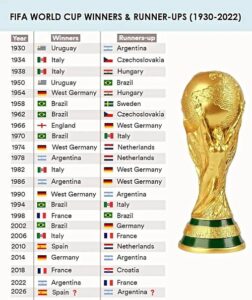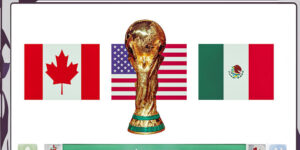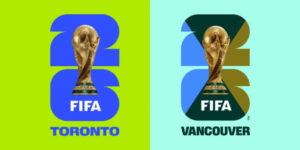The FIFA World Cup stands as the pinnacle of international football, uniting nations in a celebration of sport, culture, and unity. As we approach the 23rd edition in 2026, anticipation builds for a tournament that promises to be rewrite history in many ways.
This forthcoming World Cup is set to introduce significant changes, including an expanded roster of participating teams and a unique tri-nation hosting arrangement. These developments aim to enhance the global reach and inclusivity of the tournament, reflecting how international football is reshaping itself.

The 2026 FIFA World Cup is set to be one of the most exciting and expansive tournaments in football history. With new teams, a fresh format, and a unique three-country hosting arrangement, the tournament is poised to leave an enduring legacy on global football.
As teams continue to battle for qualification, the excitement only grows, promising a spectacle that will captivate football fans worldwide.
Sportdailyfeeds has prepared a comprehensive work to update you on all you need to know about the forthcoming World Cup. We will explore the key details of the 2026 tournament, from the host nations and cities to the innovative format and schedule.
Additionally, we will provide insights into the qualification process and the countries that have secured their spots, offering a comprehensive understanding of what to expect in this landmark event.

By examining these aspects, we aim to provide a thorough overview of the 2026 FIFA World Cup, celebrating its legacy and anticipating the new chapters that will unfold on football’s grandest stage.
Evolution of the FIFA World Cup
Since its inception in 1930, the FIFA World Cup has undergone significant transformations, mirroring the growth and globalization of football.
The inaugural tournament in Uruguay featured 13 teams, primarily from the Americas and Europe, setting the stage for what would become the world’s most-watched sporting event. As the tournament progressed, its popularity surged, leading to an expansion in both the number of participating teams and the global audience.

By 1982, the World Cup had expanded to include 24 teams, reflecting the increasing competitiveness and interest in international football. This format persisted until 1998, when the tournament further expanded to 32 teams, a structure that remained in place through the 2022 edition.
In January 2017, FIFA announced a landmark decision to expand the World Cup to 48 teams, starting with the 2026 tournament. This expansion aims to provide more nations with the opportunity to participate in football’s grandest stage, further enhancing the tournament’s global reach.

The new format introduces 12 groups of four teams each, with the top two teams from each group, along with the eight best third-placed teams, advancing to a Round of 32. This structure increases the total number of matches to 104, extending the tournament duration to 39 days.
The decision to expand the tournament reflects FIFA’s commitment to promoting football worldwide, allowing emerging football nations to showcase their talents and fostering a spirit of global unity through sport.
While the expansion presents logistical challenges, it also offers an unprecedented opportunity to celebrate the beautiful game on an even larger scale.
Previous World Cup Winners
Throughout its storied history, the FIFA World Cup has crowned eight different nations as champions, each etching their names into footballing lore.
Brazil stands atop the list with five titles, showcasing a legacy of samba football that has captivated audiences worldwide. Their triumphs in 1958, 1962, 1970, 1994, and 2002 demonstrates the Brazilian tradition of excellence and a conveyor belt of talent that has produced legends like Pelé, Romário, and Ronaldo.

Germany and Italy follow closely, each boasting four World Cup victories. Germany’s successes in 1954, 1974, 1990, and 2014 reflect a nation renowned for its tactical discipline and resilience.
Italy’s triumphs in 1934, 1938, 1982, and 2006 displays their rich footballing heritage marked by defensive mastery and moments of attacking brilliance.
Argentina, the reigning champions as of 2022, have secured three titles. Their victories in 1978, 1986, and 2022 are celebrated for the artistry of players like Diego Maradona and Lionel Messi, whose performances have left an indelible mark on the sport.

France has also claimed two titles, with their wins in 1998 and 2018 showcasing a blend of youthful exuberance and experienced leadership.
Uruguay, the inaugural World Cup winners in 1930, added a second title in 1950, demonstrating early dominance in international football.
England’s sole triumph in 1966 and Spain’s victory in 2010 complete the list of World Cup-winning nations, each achieving glory on home soil and abroad, respectively.
Host Nations and Cities for the 2026 FIFA World Cup
The 2026 FIFA World Cup marks a historic milestone as the first edition to be jointly hosted by three nations: the United States, Canada, and Mexico.

This unprecedented collaboration is as a result of a shared commitment to celebrating football across North America, which also explains the sport’s unifying power.
The tournament will feature matches in 16 cities across these countries, each offering unique cultural experiences and state-of-the-art facilities.
In the United States, 11 cities have been selected to host matches: Atlanta, Boston, Dallas, Houston, Kansas City, Los Angeles, Miami, New York/New Jersey, Philadelphia, San Francisco Bay Area, and Seattle. These cities boast world-class stadiums, such as the AT&T Stadium in Dallas and the MetLife Stadium in New Jersey, which will host the final match on July 19, 2026.

Canada will contribute two host cities: Toronto and Vancouver, as Toronto’s BMO Field and Vancouver’s BC Place are set to welcome fans and teams.

Mexico, with a rich World Cup history, will host matches in three cities: Mexico City, Guadalajara, and Monterrey. The iconic Estadio Azteca in Mexico City, which has previously hosted the finals of the 1970 and 1986 World Cups, will once again play a pivotal role in the tournament. This stadium is steeped in history, having witnessed legendary moments, including Pelé’s triumph with Brazil in 1970 and Diego Maradona’s “Hand of God” goal in 1986.
The selection of three host nations signifies FIFA’s commitment to making the 2026 tournament the most accessible and widely attended World Cup in history.
With expanded infrastructure and well-developed transport networks, these cities are well-equipped to welcome millions of fans from around the world, ensuring a smooth and exciting tournament experience.
Tournament Schedule
The 2026 FIFA World Cup is scheduled to begin on June 11, 2026, with the opening match expected to be held at Estadio Azteca in Mexico City. This stadium was mainly chosen due to its historic significance as well as its ability to host large-scale events with a passionate footballing atmosphere.
The group stage will span approximately two weeks, featuring 104 matches in total across all host cities. With an expanded format, the tournament will now accommodate more matches, allowing for increased fan engagement and economic opportunities for the host nations.

The knockout stage will begin with the Round of 32, where the best-performing teams will compete in a single-elimination format. This round is expected to increase the intensity of competition, as previously, the tournament moved directly from the group stage to the Round of 16.
The final is set for July 19, 2026, at MetLife Stadium in East Rutherford, New Jersey. This stadium, home to major sporting events, will provide a grand stage for the world’s best teams to battle for the prestigious trophy.
The closing ceremony is expected to be a spectacular celebration of football, featuring performances and tributes to the sport’s global impact.
Match Format and Structure
With the expansion to 48 teams, FIFA has introduced a new group-stage format consisting of 12 groups of four teams each. This means that every team will play a minimum of three matches in the group stage. The top two teams from each group, along with the eight best third-placed teams, will advance to the Round of 32.
The new format ensures more knockout matches, adding an additional layer of excitement and unpredictability to the tournament. This structure also increases the number of opportunities for underdog teams to progress deeper into the competition.
The introduction of a Round of 32 allows for a more inclusive and balanced competition. Previously, some teams were eliminated after just three matches in the group stage, but the new system gives an increased number of teams a chance to showcase their skills in a knockout setting.

The tournament’s duration will extend to 39 days, ensuring players have adequate rest between matches. FIFA has also committed to maintaining fair scheduling, reducing fixture congestion to prevent player fatigue, which has been a major concern in previous editions.
The expanded format represents a shift in FIFA’s approach to the World Cup, prioritizing both commercial benefits and sporting fairness. While some critics argue that an increased number of matches may dilute the tournament’s competitiveness, others view it as a step toward greater global representation in football.
Countries That Have Qualified
As of March 27, 2025, several nations have secured their qualification for the 2026 FIFA World Cup. Argentina, the defending champions, were among the first teams to qualify, reaffirming their status as one of the dominant forces in international football.
Their qualification came after a commanding 4-1 victory over Brazil, a match that exposed their determination to defend their title.

The host nations too, Canada, Mexico, and the United States, have automatically qualified as per FIFA’s traditional practice. This allows them to focus on preparation and friendly matches leading up to the tournament, ensuring their teams are well-prepared for the challenge ahead.
Japan became the first team to qualify through the standard qualification process, solidifying their reputation as Asia’s most consistent footballing powerhouse. With a strong squad featuring emerging talents, Japan is expected to be a formidable competitor in the group stage.
Additionally, New Zealand and Iran have also booked their spot at the world cup, with Iran qualifying for the fourth consecutive time.

The qualification process remains ongoing for other nations across the world. UEFA (Europe), CONMEBOL (South America), CAF (Africa), AFC (Asia), CONCACAF (North America), and OFC (Oceania) are each conducting their respective qualification tournaments to determine the final list of teams that will participate.

Fans eagerly await the full list of qualified teams, as the final lineup will determine the group-stage matchups and potential rivalries that could emerge in the tournament. The competition for qualification spots remains fierce, with several high-profile teams still fighting for a place in the World Cup.
Final Thoughts on the 2026 FIFA World Cup
The 2026 FIFA World Cup is shaping up to be a groundbreaking event in the history of international football. With an expanded format, a tri-nation hosting arrangement, and an increased number of matches, the tournament promises to be more inclusive and globally representative than ever before.

For players, the World Cup remains the ultimate stage to showcase their talent, and for nations, it offers a chance to unite their people through the power of sport.
With new countries joining the fray and traditional powerhouses aiming to reclaim glory, the competition is set to be more unpredictable than ever.
Beyond the sport, the economic and cultural impact of the 2026 FIFA World Cup will be immense. The host nations will experience a surge in tourism, business opportunities, and infrastructure development, further emphasizing football’s ability to drive global growth.
As teams continue to battle for qualification and preparations intensify, the excitement surrounding the tournament continues to build.

The 2026 World Cup is set to deliver unforgettable moments, showcase emerging talents, and reinforce football’s position as the world’s most beloved sport.
FAQs
1. When will the 2026 FIFA World Cup take place?
The tournament is scheduled from June 11 to July 19, 2026.
2. Which countries are hosting the 2026 World Cup?
The United States, Canada, and Mexico are co-hosting the tournament.
3. How many teams will participate in the 2026 World Cup?
A total of 48 teams will compete, an increase from the previous 32-team format.
4. What is the new format for the 2026 World Cup?
The tournament will feature 12 groups of four teams each, with the top two from each group and the eight best third-placed teams advancing to the Round of 32.
5. Which city will host the opening match?
The opening match is set to take place at Estadio Azteca in Mexico City.
6. Where will the final match be held?
The final is scheduled for MetLife Stadium in East Rutherford, New Jersey.
7. Have any teams qualified for the 2026 FIFA World Cup yet?
Yes, as of March 27, 2025, Argentina has qualified, along with host nations Canada, Mexico, and the United States. Japan has also secured qualification.
8. How does the qualification process work for the expanded tournament?
Each football confederation has its own qualification process, with a set number of slots allocated based on FIFA’s guidelines.
9. Will the 2026 FIFA World Cup use VAR (Video Assistant Referee)?
Yes, VAR is expected to be used, as it has become a standard feature in major international tournaments.
10. How many matches will be played in total?
The expanded tournament format increases the total number of matches from 64 to 104.
11. Will there be any new countries participating for the first time?
The expanded format increases the likelihood of debutant nations qualifying, though the final list will be determined upon completion of the qualification matches.
12. Will there be changes to the extra-time and penalty shootout rules?
FIFA has not announced significant changes, but standard rules for extra time and penalties are expected to remain in place.
13. Where can fans watch the 2026 FIFA World Cup?
The tournament will be broadcast globally on various sports networks and streaming platforms.
14. How will ticket prices be determined?
FIFA will announce ticket pricing closer to the tournament, with prices varying based on match stage, location, and demand.
15. When will the full list of qualified teams be finalized?
The qualification process is expected to conclude in early 2026, with the official tournament draw taking place afterward.
16. How will the matches be distributed among the host countries?
The tournament will be spread across 16 cities in the United States, Canada, and Mexico. The majority of matches will take place in the U.S., while Canada and Mexico will host a significant number of group-stage and early knockout-stage games.
17. Why was the tournament expanded to 48 teams?
FIFA expanded the tournament to increase global participation, provide more opportunities for smaller footballing nations, and enhance the commercial and entertainment value of the event.
18. Which teams are the favorites to win the 2026 FIFA World Cup?
Traditional powerhouses like Brazil, Argentina, France, Germany, and Spain are expected to be strong contenders, but emerging teams from Africa and Asia may also pose a challenge.
19. How will the expanded format impact the scheduling of club football?
FIFA has coordinated with major football leagues to adjust schedules around the tournament, but concerns remain about player fatigue due to increased match intensity.
20. Are there sustainability initiatives for the 2026 FIFA World Cup?
Yes, FIFA has pledged to make the tournament as eco-friendly as possible, focusing on sustainable stadium infrastructure, carbon offsetting, and responsible event management.



















